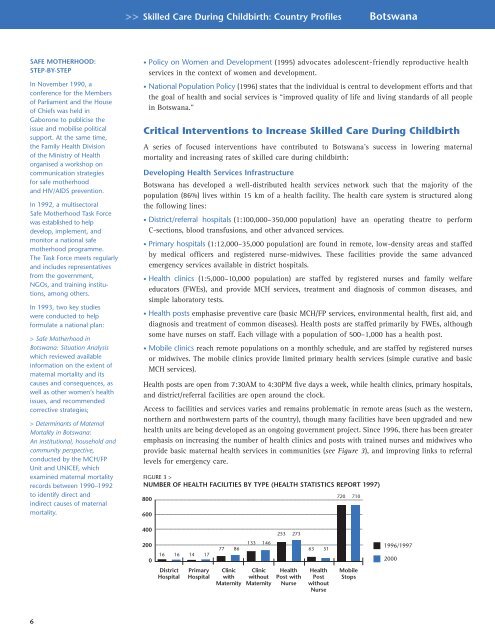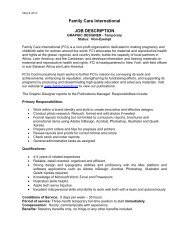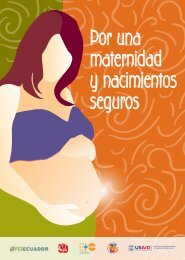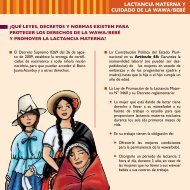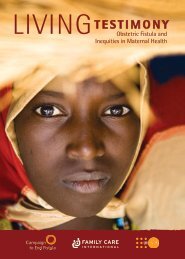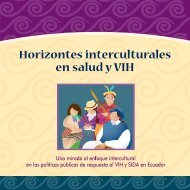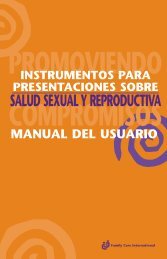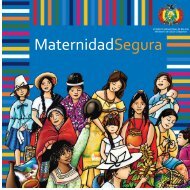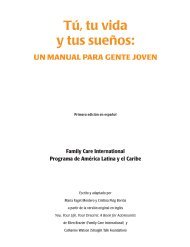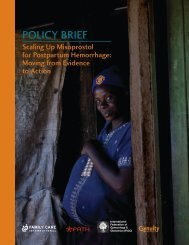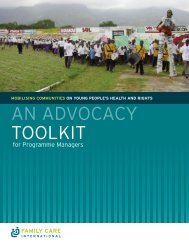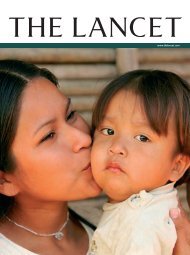SKILLED CARE DURING CHILDBIRTH - Family Care International
SKILLED CARE DURING CHILDBIRTH - Family Care International
SKILLED CARE DURING CHILDBIRTH - Family Care International
You also want an ePaper? Increase the reach of your titles
YUMPU automatically turns print PDFs into web optimized ePapers that Google loves.
Skilled <strong>Care</strong> During Childbirth: Country Profiles Botswana<br />
SAFE MOTHERHOOD:<br />
STEP-BY-STEP<br />
In November 1990, a<br />
conference for the Members<br />
of Parliament and the House<br />
of Chiefs was held in<br />
Gaborone to publicise the<br />
issue and mobilise political<br />
support. At the same time,<br />
the <strong>Family</strong> Health Division<br />
of the Ministry of Health<br />
organised a workshop on<br />
communication strategies<br />
for safe motherhood<br />
and HIV/AIDS prevention.<br />
In 1992, a multisectoral<br />
Safe Motherhood Task Force<br />
was established to help<br />
develop, implement, and<br />
monitor a national safe<br />
motherhood programme.<br />
The Task Force meets regularly<br />
and includes representatives<br />
from the government,<br />
NGOs, and training institutions,<br />
among others.<br />
In 1993, two key studies<br />
were conducted to help<br />
formulate a national plan:<br />
> Safe Motherhood in<br />
Botswana: Situation Analysis<br />
which reviewed available<br />
information on the extent of<br />
maternal mortality and its<br />
causes and consequences, as<br />
well as other women’s health<br />
issues, and recommended<br />
corrective strategies;<br />
> Determinants of Maternal<br />
Mortality in Botswana:<br />
An institutional, household and<br />
community perspective,<br />
conducted by the MCH/FP<br />
Unit and UNICEF, which<br />
examined maternal mortality<br />
records between 1990–1992<br />
to identify direct and<br />
indirect causes of maternal<br />
mortality.<br />
• Policy on Women and Development (1995) advocates adolescent-friendly reproductive health<br />
services in the context of women and development.<br />
• National Population Policy (1996) states that the individual is central to development efforts and that<br />
the goal of health and social services is “improved quality of life and living standards of all people<br />
in Botswana.”<br />
Critical Interventions to Increase Skilled <strong>Care</strong> During Childbirth<br />
A series of focused interventions have contributed to Botswana’s success in lowering maternal<br />
mortality and increasing rates of skilled care during childbirth:<br />
Developing Health Services Infrastructure<br />
Botswana has developed a well-distributed health services network such that the majority of the<br />
population (86%) lives within 15 km of a health facility. The health care system is structured along<br />
the following lines:<br />
• District/referral hospitals (1:100,000–350,000 population) have an operating theatre to perform<br />
C-sections, blood transfusions, and other advanced services.<br />
• Primary hospitals (1:12,000–35,000 population) are found in remote, low-density areas and staffed<br />
by medical officers and registered nurse-midwives. These facilities provide the same advanced<br />
emergency services available in district hospitals.<br />
• Health clinics (1:5,000–10,000 population) are staffed by registered nurses and family welfare<br />
educators (FWEs), and provide MCH services, treatment and diagnosis of common diseases, and<br />
simple laboratory tests.<br />
• Health posts emphasise preventive care (basic MCH/FP services, environmental health, first aid, and<br />
diagnosis and treatment of common diseases). Health posts are staffed primarily by FWEs, although<br />
some have nurses on staff. Each village with a population of 500–1,000 has a health post.<br />
• Mobile clinics reach remote populations on a monthly schedule, and are staffed by registered nurses<br />
or midwives. The mobile clinics provide limited primary health services (simple curative and basic<br />
MCH services).<br />
Health posts are open from 7:30AM to 4:30PM five days a week, while health clinics, primary hospitals,<br />
and district/referral facilities are open around the clock.<br />
Access to facilities and services varies and remains problematic in remote areas (such as the western,<br />
northern and northwestern parts of the country), though many facilities have been upgraded and new<br />
health units are being developed as an ongoing government project. Since 1996, there has been greater<br />
emphasis on increasing the number of health clinics and posts with trained nurses and midwives who<br />
provide basic maternal health services in communities (see Figure 3), and improving links to referral<br />
levels for emergency care.<br />
FIGURE 3 ><br />
NUMBER OF HEALTH FACILITIES BY TYPE (HEALTH STATISTICS REPORT 1997)<br />
800<br />
600<br />
720 710<br />
400<br />
253 273<br />
133 146<br />
200<br />
1996/1997<br />
77 86<br />
63 51<br />
16 16 14 17<br />
0 2000<br />
District<br />
Hospital<br />
Primary<br />
Hospital<br />
Clinic<br />
with<br />
Maternity<br />
Clinic<br />
without<br />
Maternity<br />
Health<br />
Post with<br />
Nurse<br />
Health<br />
Post<br />
without<br />
Nurse<br />
Mobile<br />
Stops<br />
6


